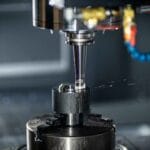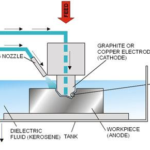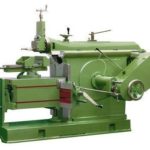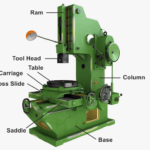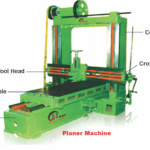We all know the most common operations performed by the drilling machine is nothing but drilling. Though drilling is an important application, many other applications can be easily performed by the drilling machine. Let us see in detail all the types of drilling operations:
1. Drilling:
Drilling is the most important and common drilling machine operation. In the drilling, we usually, produce a cylindrical hole inside the workpiece and remove the material inside it. Here, the material is removed by the rotating edge of the cutting tool. And that rotating edge is called a drill.

Drilling does not produce a fine hole. The internal surface of the hole is usually rough, and the hole is always bigger than the drill size.
Suppose if we have a drill of 12mm dimeter then, the size of the hole produced by it may be 12.125 mm or greater than that.
2. Boring:

Boring is a type of drilling operation in which we increase the diameter of the hole which was previously produced. Boring is done due to the following reasons:
- It is implemented for machining the internal surface of the hole which was produced by the casting process.
- For correcting the roundness of the hole.
- For finishing the hole correctly and for making it of the required size.
The boring tool is used for this process. The boring tool has only one cutting edge. The boring tool is placed in a boring bar which has a tapered shank. The speed of the spindle in the boring is usually very less than the reaming.
3. Spot Facing:

In the spot facing, the surface around the hole is squared. In this process, that surface also gets finished. For spot facing, a counterbore or any other spot facing tool is used.
Also Read:
- Types of Milling Cutters Used in Machining Process
- What is Lathe Machine? Main parts, Operations and Working
- Difference Between Up Milling and Down Milling – Which is Better?
4. Tapping:

In tapping, a tap is used for making internal threads. That means tap works as a cutting tool inside the tapping.
Tapping in a drilling machine can be performed by hand. Or you can also use any external power for doing this.
The metal is removed, when the tap is inserted into the hole. Tap also produces internal threads which can be fit into the external threads of the identical size.
5. Counterboring:

In the counterboring, the end of the hole is enlarged cylindrically. A counterbore works as a tool in the counterboring.
The counterbore consists of cutting edges. These cutting edges may be straight or spiral. The cutting speed in the counterboring process is usually slow. Typically, this cutting speed is 25% smaller than that of the speed in the drilling.
6. Reaming:

The size of the hole after the drilling process may not be perfect. Most of the time, its internal surface may not be finished properly.
Reaming is done to obtain the desired size of the hole. Also, the internal surface of the hole gets appropriately finished with this process. Reamer is used for reaming. Reamer is a multi-point cutting tool.
The important benefit of the reaming is that it can remove an extremely small amount of metal approximately 0.375 mm
The spindle speed in reaming is half of that of the drilling process.
7. Countersinking:

Have you ever tried of making a coned shaped hole? It is tough to make such types of holes. Countersinking is usually done to make a cone-shaped enlargement at the end of the hole. The included angle of the conical surface may be 60ۜº to 90º.
A countersink has multiple cutting edges on its conical surface.
Conclusion:
So, these are the operations involved in the drilling process. For performing these drilling operations perfectly, you must require some skillset. An inexperienced individual may do these operations in the wrong manner.
In this post, we have learned about all drilling operations performed in the drilling machine. If you have any queries about these operations then, please let us know in the comments. Thanks for reading this article.

